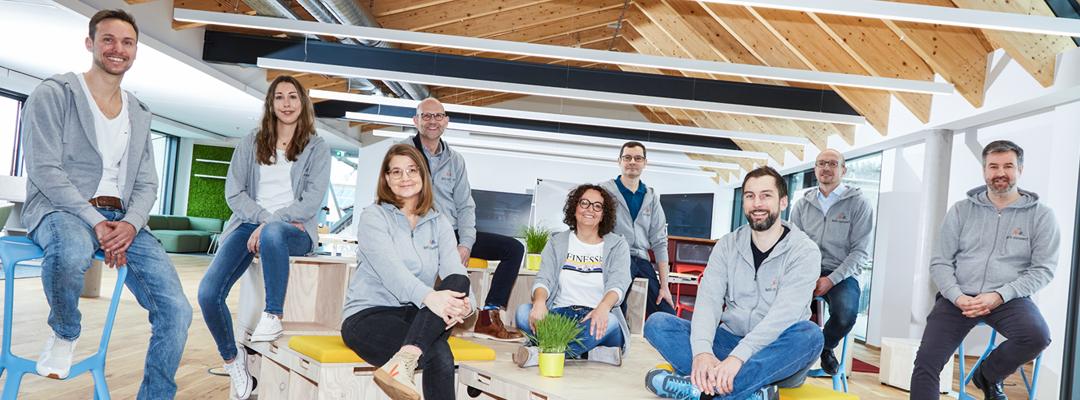
Magazine for the Annual Report
Knowledge: dare to share

Our knowledge is getting too much for our heads to hold! And that’s good – because it should not stay in our heads. What applies for love also applies for knowledge, says the Let’s Connect team: If we share it, the chances are good that it will grow. That it will enable other people to do new things. To experience more; possibly to create more with new stimuli. More and more large companies (such as Bosch and Daimler) are relying on corporate communities to solve just such situations. Those behind Let’s Connect want to prepare the stage for this at SICK, too. Markus Dambacher, Dirk Eyfrig and Ute Hettel have been involved with this from the start.
“Sharing knowledge is not a new approach. But we want to restructure parts of this,” explains Markus Dambacher, a developer who has been actively working in communities and forums for many years. “Imagine the following: In an organization like SICK, I am looking for an expert on a particular type of software. If I’m lucky, I know who I have to talk to or someone I know knows. Then I ask this expert and she helps me make progress. At the same time, five colleagues have the same problem independently of me and each other. Four also find this expert; one doesn’t. The expert therefore answers the same question five times – and the wheel is re-invented once. This is not efficient.”
“Now let’s imagine that our software expert could make her knowledge available to an interested community in a way that was completely transparent, comprehensible and easy to find? Everyone could access it, work with it, and even perhaps further develop it by means of their feedback,” adds Ute Hettel, for whom such communities are close to the heart. “For us, the self-organized exchange of experiences plays a central role in collaboration. We want to create a space in which all collaborating employees are networked in communities and can share experiences and knowledge, find answers, and develop new ideas together.”
Sharing is caring
Making knowledge and the communities themselves visible is an important prerequisite for ensuring that this type of knowledge organization and enrichment can function properly. “That’s why we are currently starting an intranet platform that we are testing with various communities,” explains Dirk Eyfrig, another early member of the Let’s Connect team. “In the future, all the communities in the company will then be able to set themselves up here. All existing communities are listed with their contacts, and any new contributions are also flagged up.”
Consulting colleagues in the communities is much more time-intensive and fundamental than preparing a technical solution. As productive knowledge platforms, self-organized communities also need certain prerequisites to be met. They should have a particular objective to promote a lively exchange of knowledge, and all members must share this aim. Because a community is only as good as its members.
“This does not mean that only experts should participate. Lack of knowledge in a real interest is just as important a driver for exchanges and discussion as the knowledge itself. After all, I can only provide answers to questions that have been asked,” notes Ute Hettel, and swiftly raises the next point that characterizes communities: They consider themselves to be a protected space in which contributions and contributors are treated with respect. “Those with the courage to ask for help will receive help here. Those with the courage to present a ‘crazy’ idea will find their sounding board and reality check here.”
“In communities we live by the principle of ‘leadership by competence’. In a community it is knowledge that counts, i.e. competence, and not hierarchies. Here, shared interest in a shared subject is what matters,” says Markus Dambacher. “Communities function from the bottom up. They are not founded to fulfil any commercial order. They are set up because someone has recognized a need, is looking for fellow campaigners, and simply makes a start. It was the same with Let’s Connect. We were initially like tender shoots spread around the company, then we got together and became a grassroots movement – and now we are growing within and into the company.”

The future comes from daring
The Let’s Connect team has been growing from the community spirit at SICK for one year now, as Dirk Eyfrig explains. “We gained supporters from within the entire company. They were very committed to this, and our team grew. We have now reached a very exciting point. We are going live with our community platform. We are starting with a beta version, a so-called minimum viable product.
We will then trial Let’s Connect and further develop it together with some active communities from the most varied of fields – and finally roll it out for everyone at SICK.” “Here it is really important to understand that Let’s Connect is not just a tool – it is an attitude. Corporate communities open up a wonderful multi-dimensionality under the umbrella of the corporate organization. They do not change organizational structures; they supplement them with a place for exchanges based on competence or interests.
Communities are the putty in the organizational structure of tomorrow. Cross-departmental work becomes a reality with their help. We always speak of big data. But big data only functions with big knowledge. Our knowledge must grow, and it must be retrievable by many people simultaneously – because only then will we be able to shape the future as quickly as it unfolds before us,“ adds Ute Hettel.







